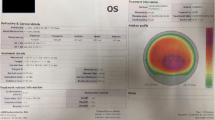Abstract
The surface ablation techniques have different names and origins. The most widely used method today includes the following steps: loosing and removing the epithelium with alcohol 20 % solution, thus exposing the Bowman layer, aiming the Excimer laser ablating through the Bowman and stroma, and applying MMC 0.02 % for a predefined time to prevent scarring. Some surgeons use MMC only for deeper ablations and some use it routinely. The peeled off epithelium is discarded (epithelium off technique) and the cornea is protected with a contact lens and local therapy. This method was described in the literature as PRK, LASEK, or Surface Ablation Technique (SAT). To simplify the discussion we will use the broadly used term PRK for these procedure. Other variations of removing the epithelium by automated separator similar to MK (Epi-K, Epi-LASIK) or ablating the epithelium (transepithelial PRK, PTK) did not show a clear advantage over PRK are used rarely as standard SAT. This book evaluates the results of the currently modern refractive surgery techniques and does not present the older history. The older PRK result suffered from low safety because of stromal Haze and optical aberrations using an optical zones of 5 mm or less, and low efficacy because of common regression. The modern PRK uses large optical zones of typically 6.5 mm or larger and MMC to prevent haze and regression.
Access this chapter
Tax calculation will be finalised at checkout
Purchases are for personal use only
Similar content being viewed by others
References
Mc Alinden C, Skiadaresi E, Moore JE. Hyperopic LASEK treatments with mitomycin C using the SCWIND AMARIS. J Refract Surg. 2011;27:380–3.
Mellington F, Jones S, Marshall J. Laser epithelial keratomileusis for the correction of hyperopia using a 7.0-mm optical zone with the schwind ESIRIS laser. J Refract Surg. 2007;23:343–54.
Moghaddam S, Arba-Mosquera S, Walter-Fincke R, Jahi S, Adili-Aghdam F. Transepithelial photorefractive keratectomy for hyperopia: a 12-month bicentral study. J Refract Surg. 2016;32(3):172–80.
De Benito-Llopis L, Alió JL, Ortiz D, Teus MA, Artola A. Ten-year follow-up of excimer laser surface ablation for myopia in thin corneas. Am J Ophthalmol. 2009;147:768–73.
Koshimizu J, Dhanuka R, Yamaguchi T. Ten- year follow-up of PRK for myopia. Graefes Arch Clin Exp Ophthalmol. 2010;248:1817–25.
Kaluzny BJ, Cieslinska I, Mosquera S, Verma S. Single-step transepithelial PRK vs alcohol-assisted PRK in myopia and compound myopic astigmatism correction. Medicine (Baltimore). 2016;95(6):e1993.
Stein RM. Comparison between hyperopic PRK and hyperopic LASIK with the VISX STAR excimer laser system. Am Acad Ophthalmol. 1999:246.
El-Agha MS, Bowmann RW, Cavanagh HD, McCully JP. Comparison of PRK and LASIK for the treatment of compound hyperopic astigmatism. J Cataract Refract Surg. 2003;29:900–7.
Scisio A, Hull CC, Baldwin H, O’Bratt D, Marshall J. Furrier analysis of induced irregular astigmatism. PRK Vs. LASIK in bilateral cohort of hyperopic patients. J Cataract Refract Surg. 2003;29(9):1709–17.
Frings A, Katz T. Presented in German ophthalmological society Congress. Leipzig. 2014.
Ivarsen A, Hjortdal J. Seven-year changes in corneal power and aberrations after PRK or LASIK. Invest Ophthalmol Vis Sci. 2012;53:6011–6.
Kirwan C, O’Keefe M. Comparative study of higher order aberrations after conventional laser in situ keratomileusis and laser epithelial keratomileusis for myopia using the Technolas 217z laser platform. Am J Ophthalmol. 2009;147:77–83.
Wallau AD, Campos M. One-year outcomes of a bilateral randomised prospective clinical trial comparing PRK with mitomycin C and LASIK. Br J Ophthalmol. 2009;93:1634–8.
Manche EE, Haw WW. Wavefront-guided laser in situ keratomileusis (LASIK) versus wavefront guided photorefractive keratectomy (PRK): a prospective randomized eye-to-eye comparison (An American Ophthalmological Society thesis). Trans Am Ophthalmol Soc. 2011;109:201–20.
Author information
Authors and Affiliations
Corresponding author
Editor information
Editors and Affiliations
Rights and permissions
Copyright information
© 2016 Springer International Publishing Switzerland
About this chapter
Cite this chapter
Katz, T.R. (2016). Safety, Efficacy and Predictability of SAT. In: Linke, S., Katz, T. (eds) Complications in Corneal Laser Surgery. Springer, Cham. https://doi.org/10.1007/978-3-319-41496-6_4
Download citation
DOI: https://doi.org/10.1007/978-3-319-41496-6_4
Published:
Publisher Name: Springer, Cham
Print ISBN: 978-3-319-41494-2
Online ISBN: 978-3-319-41496-6
eBook Packages: MedicineMedicine (R0)




